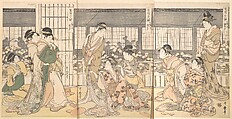Three Intoxicated Courtesans
Kitagawa Utamaro Japanese
Not on view
Utamaro's use of silhouette to render the enormous length of the Green House and its inhabitants is unquestionably bold. Three groups of courtesans stand on a balcony, and the tops of the blossoming cherry trees in the courtyard are visible behind them. The silhouettes visible across the courtyard reinforce the almost claustrophobic lack of privacy afforded by these pleasure houses. Utamaro's inscriptions describe the various reactions people have when intoxicated. They are, from right to left: anger, crying, and laughter.
This dramatic triptych displays an unusually subdued color palette for Utamaro. So limited is his palette that the artist utilizes the color of the unprinted paper as part of the design on the courtesans' robes. The large oban format became popular at the end of the eighteenth century, replacing the smaller chuban format favored by such artists as Harunobu. Utamaro's use of silhouette to render the enormouse length of the Green House and its inhabitants is unquestionably bold. Three groups of courtesans stand on a balcony, and the tops of the blossoming cherry trees in the courtyard are visible behind them. The silhouettes visible across the courtyard reinforce the almost claustrophobic lack of privacy afforded by these pleasure houses. The print is a humorous morality tale of the dangers of alchohol. Utamaro's inscriptions describe the various reactions people have when intoxicated. The are, from left to right: laughter, crying, and anger. Teacups strewn on the ground and the women's unusually animated expressions are further testimony to the hazards of drink. Courtesans were expected to be the very model of civilized women displaying intelligence, refinement, and grace. The inconsonance of this scene with the ideal only adds to its wit and affirms Utamaro's imaginative approach.
This image cannot be enlarged, viewed at full screen, or downloaded.

